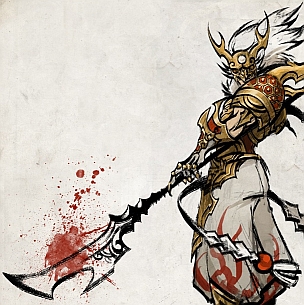Peanuts Not Included
Today I bring you another archetype, this one for barbarians.
Jotunkin

The jotunkin are barbarians whose bloodlines contain a trace of giant. When these barbarians rage, their giantish heritage manifests itself in greater size and strength.
Jotunrage (Su): A jotunkin can call upon supernatural sources of strength and ferocity, granting him greater size and prowess. Starting at 1st level, a jotunkin can jotunrage for a number of rounds per day equal to 4 + his Constitution modifier. At each level after 1st, he can jotunrage for 2 additional rounds. Temporary increases to Constitution, such as those gained from rage and spells like bear’s endurance, do not increase the total number of rounds that a jotunkin can jotunrage per day. A jotunkin can enter jotunrage as a free action. The total number of rounds of jotunrage per day is renewed after resting for 8 hours, although these hours do not need to be consecutive.
While in jotunrage, a barbarian increases in size by one size category. He gains a +4 size bonus to Strength and Constitution, a -2 size penalty to Dexterity (to a minimum of 1), and a -1 penalty on attack rolls and AC due to its increased size. He also gains a +2 natural armor bonus. The increase to Constitution grants the jotunkin 2 hit points per Hit Dice, but these disappear when the rage ends and are not lost first like temporary hit points. While in rage, a jotunkin cannot use any Charisma-, Dexterity-, or Intelligence-based skills (except Acrobatics, Fly, Intimidate, and Ride) or any ability that requires patience or concentration.
A jotunkin whose size increases to Large has a space of 10 feet and a natural reach of 10 feet. If insufficient room is available for the growth, the jotunkin attains the maximum possible size and may make a Strength check (using his increased Strength) to burst any enclosures in the process. If he fails, he is constrained without harm by the materials enclosing him.
All equipment worn or carried by the jotunkin is similarly enlarged by the jotunrage. Melee weapons affected deal more damage (see Table: Medium/Large Weapon Damage). Other magical properties are not affected by this ability. Any enlarged item that leaves a jotunkin’s possession (including a projectile or thrown weapon) instantly returns to its normal size. This means that thrown and projectile weapons deal their normal damage. Magical properties of enlarged items are not increased by this ability.
A jotunkin can end his jotunrage as a free action and is fatigued after rage for a number of rounds equal to 2 times the number of rounds spent in the jotunrage. A jotunkin cannot enter a new rage while fatigued or exhausted but can otherwise enter rage multiple times during a single encounter or combat. If a jotunkin falls unconscious, his jotunrage immediately ends, placing him in peril of death.
Jotunrage does not stack with magical effects that increase size.
This ability replaces rage.
Fear’s Friend (Ex): At 3rd level, a jotunkin gains a +1 competence bonus to Intimidate checks. These bonuses increase by +1 every three jotunkin levels thereafter (6th, 9th, 12th, 15th, and 18th level). The jotunkin also receives an insight bonus to saves against fear effects equal to one-half the competence bonus to Intimidate checks (drop fractions).
This ability replaces trap sense.
Greater Jotunrage (Su): At 11th level, when a jotunkin enters jotunrage, his size bonus to Strength increases to +6 and his natural armor bonus increases to +3.
This ability replaces greater rage.
Jotunrage Form (Su): At 14th level, when a jotunkin enters jotunrage, he may choose to assume the form of a frost giant, fire giant, hill giant, or stone giant. Once he assumes his new form, he gains the following abilities (instead of those normally granted by jotunrage): +6 size bonus to Strength, -2 size penalty to Dexterity, +4 size bonus to Constitution, +4 natural armor bonus, low-light vision, rock catching, and rock throwing (range 60 feet, 2d6 damage). If the giant has immunity or resistance to any elements, the jotunkin gains resistance 20 to those elements. If the giant has vulnerability to an element, the jotunkin gains that vulnerability.
Every round in jotunrage form counts as 2 rounds against the jotunkin’s total number of rounds per day for jotunrage. In all other respects, jotunrage form is the same as jotunrage.
This ability replaces indomitable will.
Mighty Jotunrage (Su): At 20th level, when a jotunkin enters jotunrage or jotunrage form, his size bonuses to Strength and Constitution increase by a further +2, and his natural armor bonus increases by a further +1.
This ability replaces mighty rage.
N.B. The 17th-level ability tireless rage applies to jotunrage but not to jotunrage form.
In other news, Dodeca Weather gets a 5-star review! Huzzah! Here’s an excerpt:
“This is one of those little pdfs that could easily be overlooked, which would seriously be a pity, for the pdf is stellar: It’s logical and Mark L. Chance’s writing is easy to understand, structured and fun. Plus, this pdf makes the whole endeavor of creating weather forecasts simple and yet varied. A great pdf, professionally presented and cool – essentially a “So what’s the weather like, anyway?”-book of the highest caliber – for less the a buck!”




